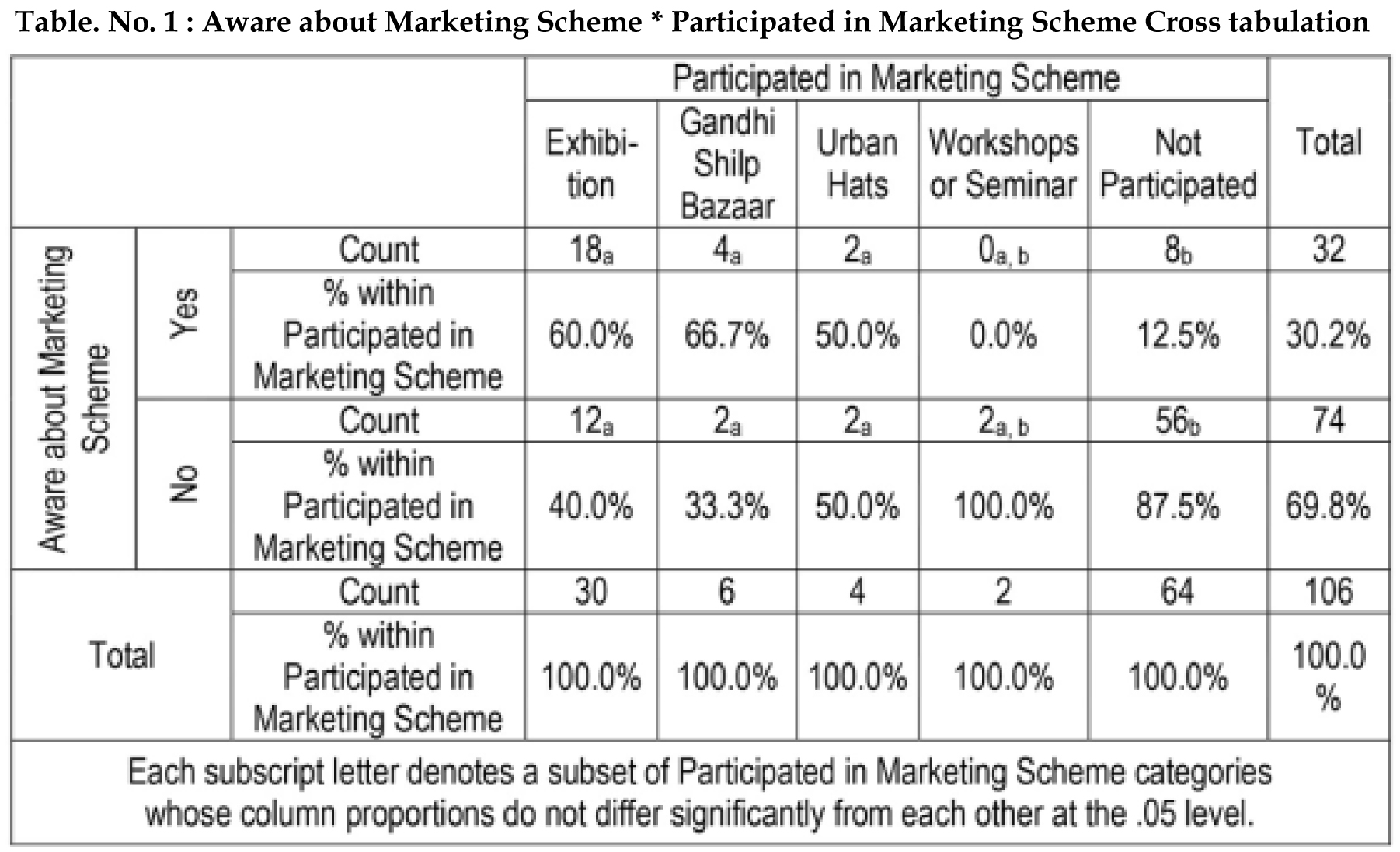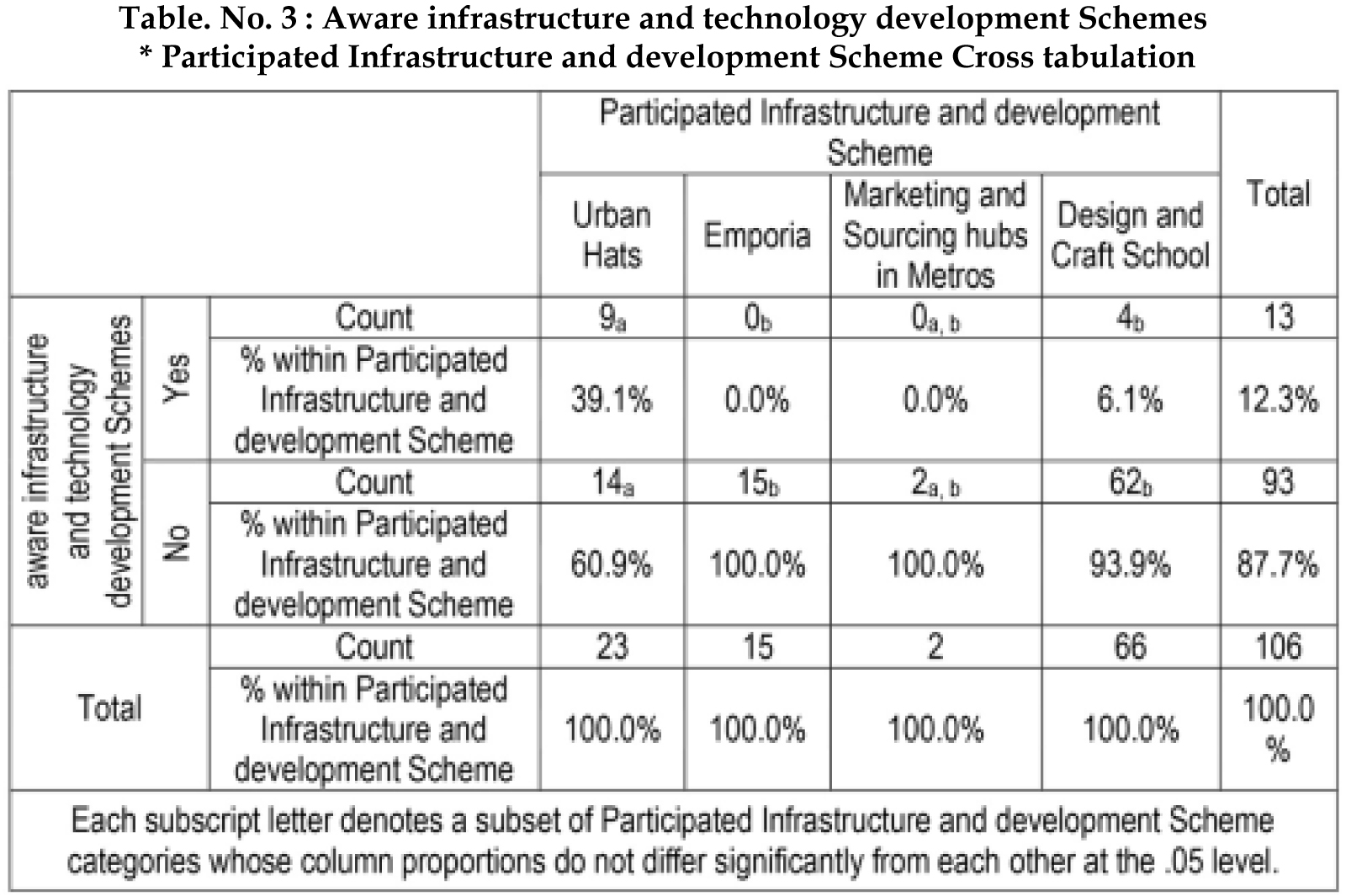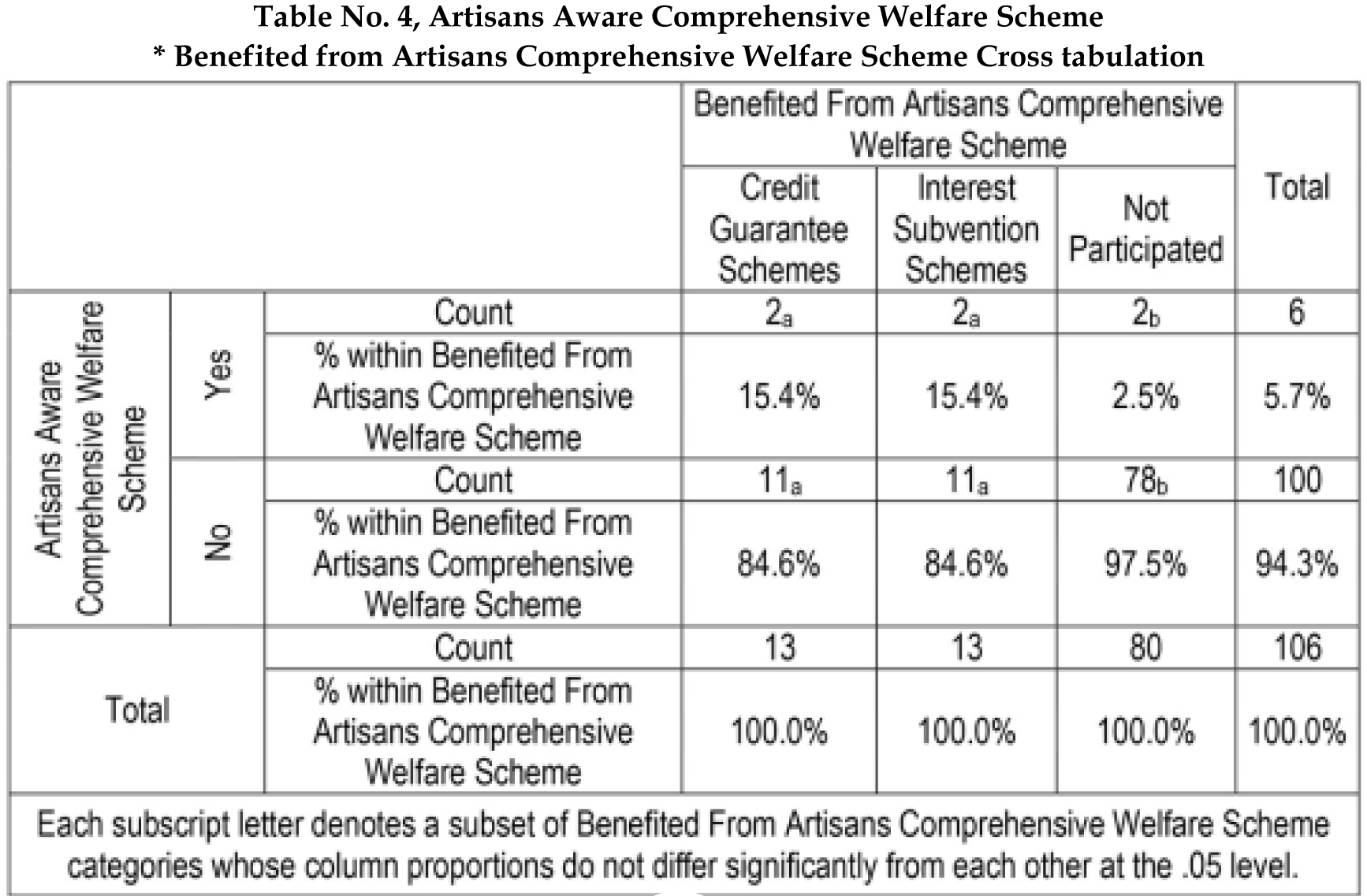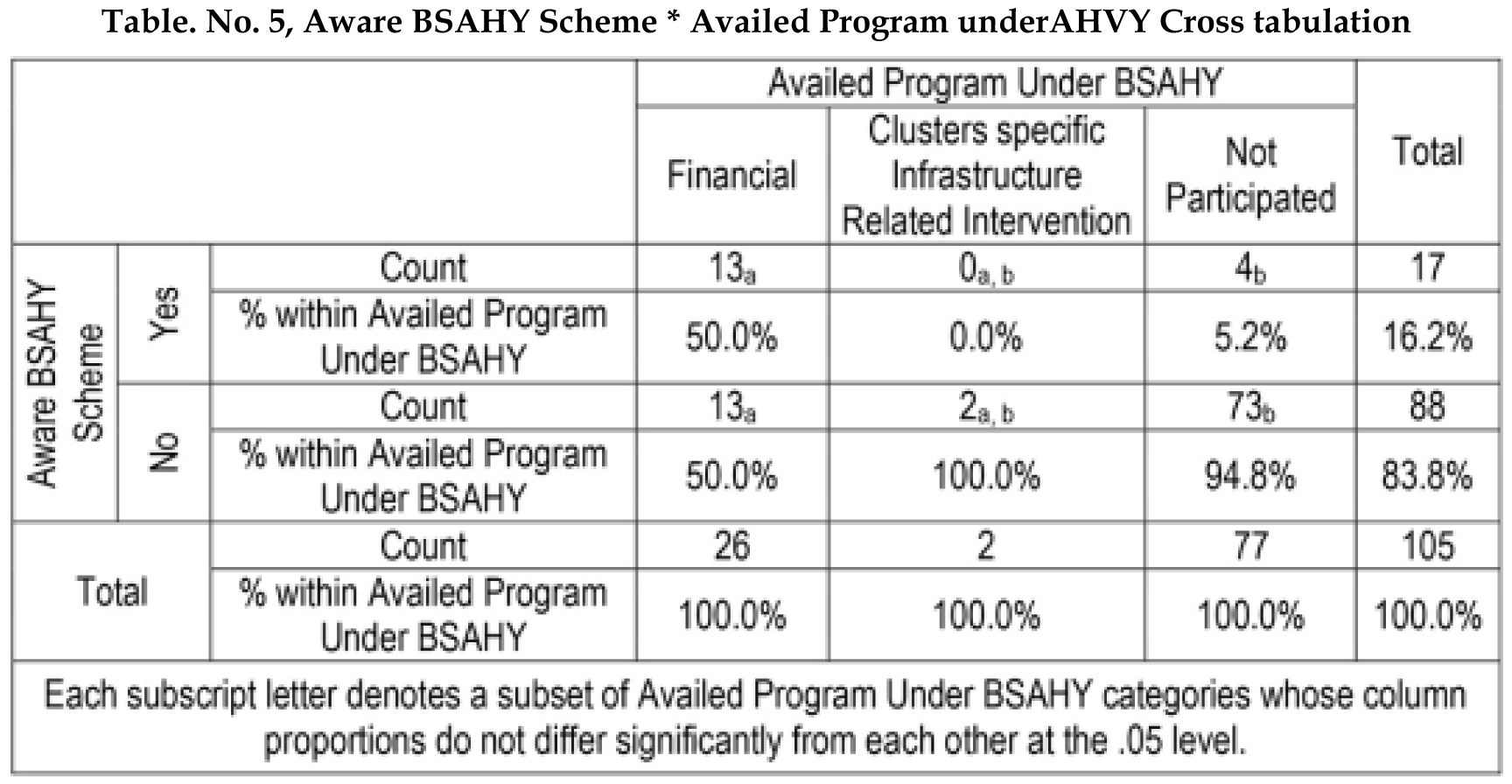Subscribe now to get notified about IU Jharkhand journal updates!
Awareness Of Government Initiated Schemes : A Study Of Handicraft Sector In Mirzapur
Abstract :
Handicraft sector is second largest unorganised and employment generation sector after agriculture in India. It was a good sources of
foreign exchange in ancient time or old days. This research paper try to examine the awareness level of handicraft schemes among the
artisan. Most of the schemes are running under the supervision of the ministry of textile but still the artisans facing financial, lack of
technical knowledge, awareness regarding government schemes, lack of market knowledge etc. The researcher reviewed different
journals, reports. Internet etc. to get the information regarding crafts but one or two paper based on the awareness of schemes among
artisans. The researcher paper is exploratory cum descriptive in nature and snowball sampling technique were used to collect the data
and cross tab method to analyse the data.
The major finding of the research paper is that most of artisans have no information about the different schemes of handicrafts. This is
the biggest hurdle to the growth and development of the sector. So, Government might be take some fruitful steps to overcome these
problems and they can use personal and non-personal methods to increase the awareness of schemes in urban and rural area.
Government should run a special campaign to increase the awareness in rural area because more than 80% artisans are living in these
area.
Keywords :
Handicraft, Schemes, Awareness, Government, Advertising etc.Introduction :
Handicrafts constitute an important segment of the
unorganized sector of our economy. As we know that
most of the Indian population are living in rural area and
in the same way most of the handicraft artisans are living
and doing their work in rural area. Most of the workers,
working as a part time but for the time being the
importance of the handicraft sector increasing.
Handicrafts have a big potential to leads employment
opportunities for the skilled and unskilled workers. In
order to overcome these constraints, BAHVY scheme has
been running under the supervision of ministry of textile
to provide them all types of amenities which is helpful to
increase the production of handicraft products.
According to the “The Office of the development
commissioner of Handicraft” the handicrafts are products
produced with a manual labour with minimal or no input
from machines, a substantial level of skill or expertise, a
significant element of tradition and its history of survival.
In the same way M. L. Meena et.al (2012),defined
handicraft is a simply as objects made by the skills of the
hand and which carry a part of the creator as well as
centuries of evolutionary tradition.
The handicraft sector has, however, suffered due to its
being unorganized, with the additional hurdles such as
lack of education, poor exposure to new technologies, low
capital, poor infrastructure and absence of market
intelligence etc. To overcome these hurdles, ministry of
textile started so many scheme to the handicraft but these
schemes are not accessible to the actual needy artisans.
According to the annual report 2017-18, the total number
of 68.86 lakhs of artisans were involved in which 30.25
lakhs are male and 38.61 lakhs are female artisans. This is
an important sector to promote women empowerment
and make them financially strong. Ministry of Textiles,
announced many awards like Shilp Guru, National award
for outstanding contributors who alive our old tradition
and different national merit certificate awards to promote
and motivate the artisans.
Mirzapur district is a part of Uttar Pradesh, its
geographical area is 4,521 sq. km with population of 4,
96,970 and one of the important contributor of handicraft
products. Mirzapur district is playing a significant role in
production and export of different crafts and an important
source to earn money for poor artisans.
Review of Literature
The following literature was reviewed related to the topic
of research during the research period :
According to the, Rahul and Sanjay (2015), the awareness
of Government schemes and policies among handicraft
artisans in Indian handicraft sector. The researchers
conducted their work through structure questionnaire in
Madhya Pradesh and found that only one third
populations is aware all types of Government schemes for
handicrafts. Handicraft sector scattered in throughout
state in small units, and it helps in foreign
exchanges,employment generation. In the same way, Jain,
R. and Sharma, S. (2015) continued the work on artisan's
perception towards Government promoting strategy in
Indian handicrafts sector. They further concluded that
some of the artisans were benefited through handicraft
bazaar/melas but they were still far away from actual
marketing support and policies. The researchers were
used structured questionnaire for artisans, retailers,
handicraft bodies and export agencies to know existing
problems of the crafts.Kumar, D. and Rajeev, P.V. (2014),
concluded that the marketing of handicraft products was a
great challenges for the sector at the present time.
Customers had less information regarding crafts items
which created a hurdled to the manufacturers or
producers as well as retailers of the crafts sector.
Then further two researchers Fabeil, F. and Rahim, I. A.
(2016) were continued their study on workshop- based
format of crafts production and they found that those
artisans who involved as a full- time workers, they were
the highest performer as compared to part time workers.
Dash, P. K (2015)examined the handicrafts sector of Orissa
and he concluded that the low wages earner of crafts were
started to changetheir works, which adversely affects the
number of small manufacturing units and its production
of crafts. Datta, H. (2016) suggested that the social,
educational and economic background of the artisans
were very poor because most the profit were earned by the
middlemen of the handicraft. So, the manufacturers or
producers of artisans should also involve in new market
exploration and developed bargaining skill to get better
price of the products. They should also take the help of
different distribution channel of Self Help Group such as
direct distribution channels, door to door selling, village
market/haats, SHGs melas(Fair) at block and district level
and regional SHG melas called 'SARAS' etc.
Datta, D. B. and Bhattacharyya, S. (2016) examined that
Indian handicraft is known for their perfection, excellent
design and varieties and a matchless sagacity of colour.
The study described the most prominent issues such as
lack of education, unorganized nature, poor exposure of
new technology, low capital, poor infrastructure and no
use of market intelligence etc. have been hampered
development of craft sector.
Nagori, N. and Saxena, K. (2012) highlighted the
importance of rural sector which potential to provide an
unexplored markets for the handicraft sector.Kumar, D.
and Rajeev, P.V. (2013), suggested that handicraft sector
should think and work according to the customer's
accessibility because at present time internet provided a
great platform where the producers and retailers provide
all necessary information about the craft items.
Vats, S. (2015), found that handicraft manufacturing units
faced several challenges including inefficient layout of
resources, high production cost, low productivity of scarce
manufacturing resources, uncertainty in supply of raw
materials, fluctuation of raw materials prices, uncertainty
in supply of raw materials, high transaction cost in
procurement of raw materials, exchanges rate fluctuation,
poor logistics infrastructure etc. Manjusmita Dash, (2011)
stated that the handicraft occupiedan inimitable place in
India but in spite of this it could not receive as much
consideration as it deserve because the performance of
institutions have not up to the mark due to the lack of basic
infrastructure facilities.
Singfat Chu (2006)described that therole of research and
development, promotional activities and advertisement
has been playing an importance role regarding creation of
awarenessamong the customers further created a valuable
brand in the mind of the customers. The creation of the
brands value is not a simple task for the enterprises but it
needs continuous effortsfor the enterprises at different
parameters likes expenditure on Research and
Development, time management, delivery system, quality
etc.
Research method
Objective :To examine the awareness of government initiative schemes among the artisans of handicraft. The present research paper is based on both descriptive as well as exploratory in nature and the population of the study was all the artisans of the Mirzapur district and sample size was 106 artisans. Snowball sampling technique were used for data collection and both primary and secondary data were used for the study. Descriptive and cross tab methods were used for the analysis of the data.
Analysis and Interpretation
Descriptive statisticsThe descriptive statistics depicted that (84.91%) respondents were male and 15.09% were female and most of the respondents were 31-40 years of age group. Majority of the artisans monthly earnings were below 5000 rupees.

Interpretation :
The table no.1, exhibited that the, 69.80% of craftsmen were unaware about the different marketing schemes such as exhibition, Gandhi shilp mela, urban hats and seminar or workshops and 30.20% were aware about the different programs. In which 56.25% were participated in exhibition, 12.50% Gandhi shilp mela, 6.25% were participated in urban hats and no one participated in different seminar or workshops organised by government to update the artisans regarding recent development in handicraft sector.

Interpretation :
The table no.2, shown that the, 88.70% population of the artisans had no information regarding Human resource development (HRD) scheme and only 11.30% craftsmen had knowledge about the HRD scheme. Among the aware artisans 33.33% had knowledge about handicraft training program, 16.67% were aware about the training through trainers and training through established institutions program etc. The above data depicted the ground veracity of the different schemes are alarming us to rethink or reorganized the different schemes according to the welfare of the artisans.

Interpretation :
The table no.3, depicted that the, 87.70% craftsmen were unaware and 12.30% were aware about different infrastructure and technological development schemes. It also depicted the same trends of awareness, which also frightening us regarding ground legitimacy of the handicraft sector. In which, 30.77% of the artisans had knowledge about the design and craft school and 69.23% artisans had familiars about the urban hats.

Interpretation :
The table no. 4, revealed that the, 94.30% of the artisans were unaware and 5.70% were aware about the different comprehensive welfare schemes, in which 33.33% were aware about the credit guarantee and interest subvention schemes.

Interpretation :
The table no. 5, depicted that the, awareness of AHVY (Baba Saheb Ambedker Hastshilp Vikas Yojana) scheme was only 16.20% in which, 50% artisans were aware and used financial scheme and same percent had no information. The major finding was 83.80% of craftsmen had no knowledge about AHVY scheme. There are many program has been working under the AHVY (Baba Saheb Ambedker Hastshilp Vikas Yojana) scheme and the main objective of this scheme is to strengthen the social, technological, marketing and financial intervention for the sustainable development of handicraft sector.
Results and Discussions :
The most important concluding remarked of the study is,
the marketing intervention scheme of the government is
focusingto organised exhibitions, to conduct study on
market assessment and products assessment, to increase
awareness through print and electronic mode etc. but the
analysis depicted that the a very few percent of artisans
were aware about different program under marketing
intervention. Government should focused to the rural area
of the country because most of the handicraftsmen were
living and working in the villages. Therefore, government
should use radio, print media and television media to
inform or to increase the awareness among the artisans
about different schemes in local languages. The
government should also use personnel and non-personnel
medium of communication in different districts of the
country after specific interval of time.
Human resource development (HRD) schemes has been
working as a backbone for any organization because it
provides different types of training and development
programs which is necessary for the progress of workers
and the organizations. So, we have to inform and motivate
craftsmen about the schemes and try to provide some
wages during the training. Government should also
provide some financial assistance to the artisans to start
their business in handicraft sector. Market for crafts items
is most prominent issues for the craftsmen after producing
the products and they need some urgent assistance to sale
their products. So, the ministry of textile should organised
a marketing campaign in the different clusters and try to
know the existing problems.
Along with these issues, most of the artisans even had no
knowledge about the design related assistance, loan for
raw material and machineriesrelated support, which is a
prime target of the government. We should promote our
indigenouswork to alive, so we need to give preference
during shopping and also to encourage our relatives and
friends to buy the crafts.
References :
- Rahul and Sanjay (2015). A Study on the Awareness of Artisan on various Government Schemes and Policies for Handicraft with Special Reference to Madhya Pradesh. Zenith International Journal of Business Economics & Management Research. Vol. 5 (11), pp. 20-28
- Jain, R, and Sharma, S. (2015). Perception of Artisans on Existing Marketing Strategy for Promotion of Indian Handicrafts. Zenith International Journal of Multidisciplinary Research, Vol.5, Oct. 2015, pp. 166- 176
- Kumar, D. and Rajeev, P.V. (2013). A new strategic approach for marketing of handicraft products. International Journal of Applied Service Marketing Perspectives. Pezzottaite Journal, Vol. 2, No. 3.
- Fabeil, F. and Rahim, I. A (2016). Sustainability of Rural Enterprise: a study of Small- Scale Handicraft Making in Sabah. Innovative Journal of Business and Management, 5:2, pp. 44-52
- Dash, P. K (2015). Tourism and community development- A Study on Handicraft Artisans of Odisha. International Journal of Innovation Education and Research, Vol. 3-3, pp. 61-72
- Ali, Z. et al. (2015). Prospects for Alleviating Poverty and Protecting the Taunsa Barrage Wildlife Sanctuary, Indus River, Pakistan, Through Cultural and Eco- Tourism, the Journal of Animal and Plant Sciences, 25(3supp. 2) 2015 Special Issue, pp. 341-347
- Rath, N. (2016). Impact of Globalization on the Urban Informal Economy: A study of the Women Craft worke r s of Odi sha . Impe r i a l Journa l of Interdisciplinary Research (IJIR), Vol. 2, Issue-6, ISSN: 2454-1362
- Datta, H. (2016). Self Help Groups in Tripura and Marketing of the Products: an Overview. Indian Journal of Applied Research, Vol. 6, Issue. 1, ISSN- 2249-555X
- Mukharjee, S. et al (2016). Exploring the potentials of Handicraft as a Promotional Tool for West Bengal Tourism. Indian Journal of Research, Vol.5, Issue. 1, ISSN- 2250-1991
- Mukhlis, I. et al. (2015). The Role of Taxation Education on Taxation Knowledge and Its Effects on Tax Fairness as well as Tax Compliance on Handicraft SMEs Sectors in Indonesia. International Journal of Financial Research, Vol. 6, No. 4, ISSN 1923-4023.
- Mogindol, S. H. and Bagul, A. H. B. B. P (2014). Tourists Perception about an Appealing Handicraft. Tourism, Leisure and Global Changes, Vol. 1, p. TOC-10
- Datta, D. B. and Bhattacharyya, S. (2016). An Analysis on Problems and Prospects of Indian Handicraft Sector. Asian Journal of Management, Vol. 7, No. 1, ISSN: 0976-495X
- Meena, M. L. and Dangayach, G. S. et al (2012). Occupational Risk Factor of Workers in the Handicraft Industry: A Short Review. International Journal of Research in Engineering and Technology (IJRET), Vol. 1, No. 3, ISSN 2277-4378
- Nagori, N. and Saxena, K. (2012) Marketing of Rural Handicraft Products through Retail Format: A Synthetic Review. Annals of Management Research, Vol.2, No. 1,
- Jena, P. K. (2007). Orissan Handicrafts in the Age of Globalization: Challenges and Opportunities. Orissa Review, Nov. 2007
- Zulaikha, E. and Brereto, M.(2013) Participatory Approach to Support Community Development of Rural Craftspeople. In Proceeding of Quality in Research, Yogyakarta, Indonesia.
- Vats, S. (2015). Women Empowerment in Gujarat- A case Study of Shree Saurashtra Rural Development Mandal, Amargadh, Palitana. An International Peer Reviewed Research Journal, Vol. 2, Issue 2, March 2015
- Chugh, S. R. (2013). Tourism vis-a-vis Native Culture- A Study of Kangra. SAJTH, Vol. 6, No. 2, July 2013.
- Kumar, D and Rajeev, P.V (2014). Marketing Challenges of Handicraft Retails in Changing Environment. Zenith International Journal of Business Economics & management Research. Vol. 4 (10), ISSN 2249-8826.
- Annual Report, 2015-16, Ministry of textile, Government of India. lAnnual Report, 2016-2017, Ministry of Textile, Government of India.
